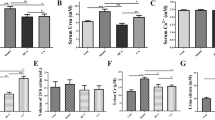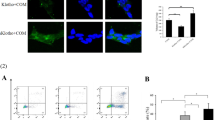Abstract
Recently, we reported that atorvastatin prevents renal tubular cell injury by oxalate and inhibits renal crystal retention. In this study, we investigated the mechanism by which atorvastatin inhibits renal crystal retention. Male Sprague-Dawley rats were separated into four experimental groups, and the ethylene glycol model of hyperoxaluria and the atorvastatin treatment model were analyzed. To clarify the mechanism by which atorvastatin inhibits renal crystal retention, the removed kidneys were used for the quantitative analysis of superoxide dismutase (SOD) and catalase. The subunits of the NADPH oxidase system were evaluated using real-time polymerase chain reaction analysis. Furthermore, the level of transforming growth factor-β (TGF-β) in kidney tissue was compared in each group. Atorvastatin treatment increased the SOD and catalase level compared with the stone-forming control group. Atorvastatin treatment decreased the expression of NOX-1 mRNA. Furthermore, the level of TGF-β was suppressed by atorvastatin treatment. We found that atorvastatin have inhibited calcium oxalate (CaOX) urolithiasis formation. We hypothesize that the mechanism of action of atorvastatin involves inhibiting TGF-β and NADPH oxidase, and increasing the SOD and catalase level. We believe that atorvastatin will be helpful in the treatment of CaOX urolithiasis.




Similar content being viewed by others
References
Siener R, Glatz S, Nicolay C et al (2003) Prospective study on the efficacy of a selective treatment and risk factors for relapse in recurrent calcium stone patients. Eur Urol 44:467–474
Khan SR (2005) Hyperoxaluria-induced oxaidative stress and antioxidants for renal protection. Urol Res 33:349–357
Takemoto M, Liao JK (2001) Pleiotropic effects of 3-hydroxy-3-methylglutaryl coenzyme a reductase inhibitors. Arterioscler Thromb Vasc Biol 21:1712–1719
Glorioso N, Troffa C, Filigheddu F et al (1999) Effect of the HMG-CoA reductase inhibitors on blood pressure in patients with essential hypertension and primary hypercholesterolemia. Hypertension 34:1281–1286
Wassmann S, Laufts U, Muller K et al (2002) Cellular antioxidant effects of atorvastatin in vitro and in vivo. Arterioscler Thromb Vasc Biol 22:300–305
Kim SI, Han DC, Lee HB (2000) Lovastatin inhibits transforming growth factor-beta1 expression in diabetic rat glomeruli and cultured rat mesangial cells. J Am Soc Nephrol 11:80–87
Toblli JE, Ferder L, Stella I et al (2002) Effects of angiotensin II subtype 1 receptor blockade by losartan on tubulointerstitial lesions caused by hyperoxaluria. J Urol 168:1550–1555
Tsujihata M, Momohara C, Yoshioka I et al (2008) Atorvastatin inhibits renal crystal retention in a rat stone forming model. J Urol 180:2212–2217
Nebat C, Moutet M, Huet P et al (1993) Spectrophotometric assay of superoxide dismutase activity based on the activated autoxidation of a tetracyclic catechol. Anal Biochem 214:442–451
Shevalye H, Stavniichuk R, Xu W et al (2010) Poly (ADP-ribose) polymerase (PARP) inhibition counteracts multiple manifestations of kidney disease in long-term streptozotocin-diabetic rat model. Biochem Pharmacol 79:1007–1014
Wheeler CR, Salzman JA, Elsayed NM (1990) Automated assays for superoxide dismutase, catalase, glutathione peroxidase and glutathione reductase activity. Anal Biochem 184:193–199
Babior BM (1999) NADPH oxidase: an update. Blood 93:1464–1476
Griendling KK, Sorescu D, Ushio-Fukai M (2000) NAD(P)H oxidase: role in cardiovascular biology and disease. Circ Res 86:494–501
Suh YA, Arnold RS, Lassegue B et al (1999) Cell transformation by the superoxidegenerating oxidase mox1. Nature 401:79–82
Chabrashvili T, Kitiyakara C, Blau J et al (2003) Effects of ANG II type 1 and 2 receptors on oxidative stress, renal NADPH oxidase, and SOD expression. Am J Physiol Renal Integr Comp Physiol 285:R117
Mizuguchi Y, Miyajima A, Kosaka T et al (2004) Atorvastatin ameliorates renal tissue damage in unilateral ureteral obstruction. J Urol 172:2456–2459
Yoshioka I, Tsujihata M, Akane W et al (2011) Angiotensin type-1 receptor blocker candesartan inhibits calcium oxalate crystal deposition in ethylene glycol-treated rat kidneys. Urology. doi:10.1016/j.urology.2010.11.019
Andreoli TE (2000) Free radicals and oxidative stress. Am J Med 108:650–651
Ebisuno S, Kohjimoto Y, Tamura M et al (1995) Adhesion of calcium oxalate crystal to Madin-Darby canine kidney cells and some effects of glycosaminoglycans on cell injuries. Eur Urol 28:68–73
Toblli JE, Ferder L, Stella I et al (2001) Protective role of enalapril for chronic tubulointerstitial lesions of hyperoxaluria. J Urol 166:275–280
Antus B, Exton MS, Rosivall L (2001) AngiotensinII: a regulator of inflammation during renal disease? Int J Immunopathol Pharmacol 14:25–30
Umekawa T, Hatanaka Y, Kurita T et al (2004) Effect of angiotensin II receptor blockage on osteopontin expression and calcium oxalate crystal deposition in the rat kidneys. J Am Soc Nephrol 15:635–644
Umekawa T, Tsuji H, Uemura H et al (2009) Superoxide from NADPH oxidase as second messenger for the expression of osteopontin and monocyte chemoattractant protein-1 in renal epithelial cells exposed to calcium oxalate crystals. Br J Urol 104:115–120
Author information
Authors and Affiliations
Corresponding author
Rights and permissions
About this article
Cite this article
Tsujihata, M., Yoshioka, I., Tsujimura, A. et al. Why does atorvastatin inhibit renal crystal retention?. Urol Res 39, 379–383 (2011). https://doi.org/10.1007/s00240-011-0370-1
Received:
Accepted:
Published:
Issue Date:
DOI: https://doi.org/10.1007/s00240-011-0370-1




